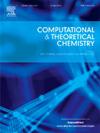Halochromism of alizarin yellow R in aqueous solution: A comparative theoretical analysis of neutral, anionic, and dianionic forms
IF 3
3区 化学
Q3 CHEMISTRY, PHYSICAL
引用次数: 0
Abstract
Photochemical transformations of alizarin yellow R with alternate elimination of two protons from the carboxyl and OH groups are modeled in the present work using TD-DFT, and the accompanying shifts of electron densities are estimated from the analysis of NPA charges. It turned out that the carboxyl group, although polarized upon excitation, is almost not involved in the photoinduced charge transfer from the aromatic A ring to the diazo linker and does not affect it. Therefore, the neutral form and the anion have an absorption maximum at the same wavelength (λmax = 374 nm). On the contrary, the OH group, although also not directly involved in this, significantly affects this process: when a proton is eliminated from it, the path of charge transfer from the A ring through the diazo linker is extended and reaches the second B ring. This leads to a significant shift of the absorption maximum of the dianion (λmax = 496 nm) relative to the neutral form and the monoanion. Moreover, photoinduced changes in the conformations of all three forms of the dye are local: in contrast to the famous parent unsubstituted azobenzene, alizarin yellow R has a trans conformation in both the ground and excited states.

茜素黄R在水溶液中的变色性:中性、阴离子和重阴离子形式的比较理论分析
本文利用TD-DFT模拟了茜素黄R在羧基和OH基上交替消去两个质子的光化学转化,并通过NPA电荷分析估计了伴随的电子密度偏移。结果表明,羧基虽然在激发时发生极化,但几乎不参与芳A环到重氮连接体的光致电荷转移,也不影响它。因此,中性形式和阴离子在同一波长处具有最大吸收(λmax = 374nm)。相反,羟基虽然也没有直接参与到这一过程中,但却显著地影响了这一过程:当其中一个质子被消除时,电荷从a环通过重氮连接体转移的路径被延长并到达第二个B环。这导致阴离子的吸收最大值(λmax = 496 nm)相对于中性形式和阴离子有显著的变化。此外,光诱导的三种形式的染料构象的变化都是局部的:与著名的母体未取代偶氮苯相比,茜素黄R在基态和激发态都有一个反式构象。
本文章由计算机程序翻译,如有差异,请以英文原文为准。
求助全文
约1分钟内获得全文
求助全文
来源期刊

Computational and Theoretical Chemistry
CHEMISTRY, PHYSICAL-
CiteScore
4.20
自引率
10.70%
发文量
331
审稿时长
31 days
期刊介绍:
Computational and Theoretical Chemistry publishes high quality, original reports of significance in computational and theoretical chemistry including those that deal with problems of structure, properties, energetics, weak interactions, reaction mechanisms, catalysis, and reaction rates involving atoms, molecules, clusters, surfaces, and bulk matter.
 求助内容:
求助内容: 应助结果提醒方式:
应助结果提醒方式:


